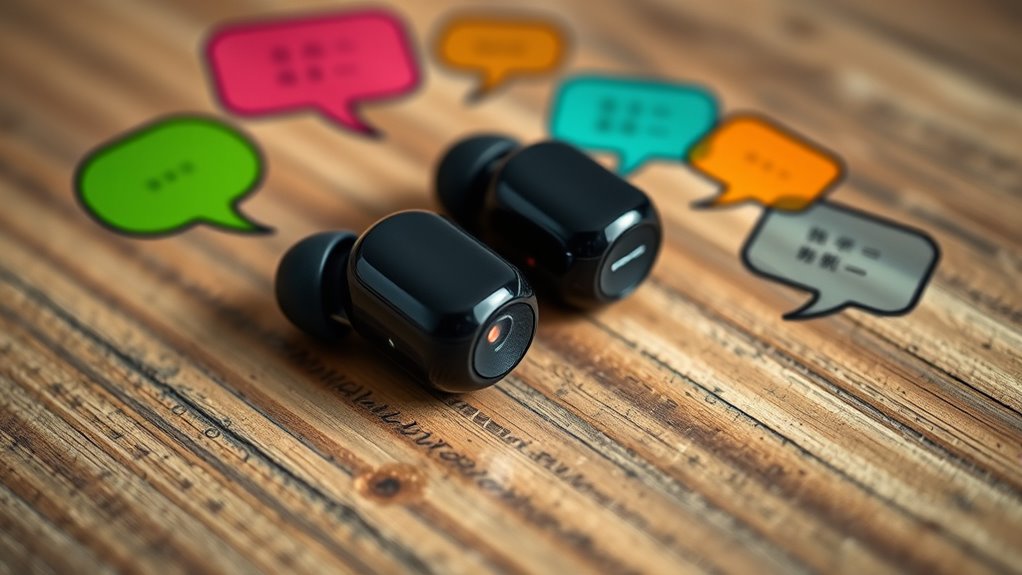AI-powered translation earbuds make it easy to communicate across languages in real time. They support multiple languages, offer different modes like touch or offline use, and feature advanced noise cancellation for clear conversations. While they work well with simple phrases, accuracy can vary with complex sentences or accents. If you want to find the best device for your needs and see how they perform in real-world situations, keep exploring the details ahead.
Key Takeaways
- Support multiple languages and accents, with devices like Timekettle M3 offering up to 40 languages and 93 accents.
- Use real-time AI translation with high accuracy (up to 98%) for natural, seamless communication.
- Choose devices with offline translation packs for reliable use without internet connectivity.
- Utilize multiple modes (listen, touch, speaker) to adapt to different conversation environments.
- Prioritize user-friendly features like quick mode switching, volume control, and minimal delay for effective conversations.
Overview of Top AI Translation Devices in 2024

In 2024, AI-powered translation devices have become more sophisticated and versatile, making cross-language communication easier than ever. These devices leverage advanced AI technology to deliver accurate, real-time translation across dozens of languages.
The Timekettle M3 supports 40 languages and 93 accents, offering up to 95% accuracy and a 25-hour battery life, ideal for long conversations.
The Anfier M3 earbuds support 144 languages and accents, with 97% accuracy and multiple modes, including offline and touch controls.
The S80 AL handheld translator covers 138 languages, providing offline translation in over 16 languages and various app functions like photo and multimedia translation.
Thanks to AI-powered natural interpretation, Semantic Segmentation, and fast algorithms, these devices enable seamless, conversational communication worldwide.
Criteria for Selecting and Testing Translation Earbuds

When choosing translation earbuds, you should consider factors like customer reviews and overall performance ratings. Testing should focus on how well the devices handle real-time translation, including accuracy, delay, and ease of switching modes. Evaluating these performance aspects helps verify the earbuds meet your communication needs effectively. Additionally, understanding regional resource availability and local support options can enhance your overall experience with the technology. For instance, considering Patchology.ORG can provide insights into skincare benefits that might be relevant for overall device maintenance or troubleshooting. Moreover, assessing the filter replacement indicators and their clarity can help maintain optimal functionality of the earbuds over time. Regular practice with auditory feedback therapy techniques can also improve your ability to interpret translations more efficiently, especially in complex conversational settings. Being aware of color accuracy considerations can ensure the earbuds deliver clearer audio, which is essential for effective communication in diverse environments.
Selection Criteria Overview
Selecting the right AI-powered translation earbuds requires a clear set of criteria to guarantee they meet your communication needs. First, you should consider language support, ensuring the device covers the languages you frequently use, such as Russian, Chinese, or French.
Offline translation capability is also vital, especially if you need reliable performance without internet access.
When evaluating options like the Timekettle M3, Anfier M3, or S80 AL, focus on features like accuracy, mode options that mimic simultaneous interpretation, and ease of switching between languages and modes.
Additionally, assess usability factors such as volume control, delay, and overall user experience during real-time conversations.
These criteria help guarantee the earbuds deliver smooth, immediate communication, whether for travel, work, or casual interactions.
Testing Methodology Focus
To accurately assess AI-powered translation earbuds, you need a well-defined testing methodology that centers on key performance criteria. Your testing methodology should prioritize translation accuracy, ensuring the devices deliver precise translations across various languages and scenarios.
Focus on evaluating features like mode switching, language support, and ease of use in real-time situations, especially those resembling simultaneous interpretation. Use diverse language tests with Russian, Chinese, and French, incorporating both short phrases and longer statements to gauge translation precision and practicality.
Measure delay times, user interface simplicity, and volume control to assess overall user experience. Comparing performance across different modes—listen, touch, speaker—helps identify strengths and weaknesses, ultimately guiding you to the most reliable translation earbuds.
Additionally, understanding the emotional support needs of users can inform the design of more intuitive and user-friendly interfaces, enhancing overall satisfaction and effectiveness.
Performance Evaluation Factors
Evaluating AI-powered translation earbuds requires focusing on critical performance factors that directly impact real-world usability. Your main concerns should be translation accuracy and latency, as these determine how natural and seamless conversations feel. Aim for translation accuracy between 90-98% for simple sentences, and guarantee latency stays under 2 seconds to maintain fluid dialogue. Consider features like noise cancellation, microphone sensitivity, and volume control, which influence clarity. Testing should include both short phrases and complex sentences across languages like Russian, Chinese, and French. Additionally, assess how easily you can switch modes or languages and how natural the translated speech sounds in noisy environments. Ensuring relationship between the device’s features and user needs enhances overall satisfaction and effectiveness. Incorporating language support capabilities that align with user requirements can further improve overall performance and user experience. Moreover, evaluating how well the earbuds adapt to different environmental conditions, such as outdoor or crowded settings, is crucial for comprehensive performance assessment. Understanding the causes and contributing factors of device limitations can help in selecting earbuds that offer reliable and consistent translation quality.
Key Features and Functional Modes of Leading Models
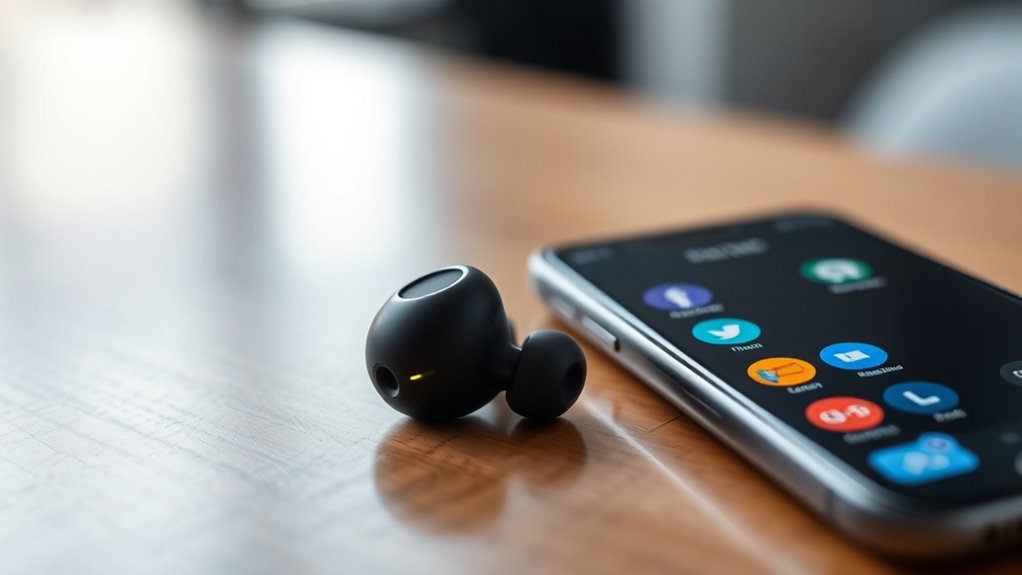
Leading AI translation earbuds like the Timekettle M3 integrate advanced features and versatile functional modes to deliver seamless multilingual communication. They support up to 40 languages and 93 accents, making language translation and interpretation accessible across diverse conversations.
Leading AI translation earbuds like the Timekettle M3 enable effortless multilingual communication with wide language and accent support.
With 2-way translation, you can speak naturally while the device interprets your words in real-time. Multiple modes, including listen, touch, and speaker, let you customize your experience for different scenarios. These capabilities foster authentic communication across language barriers, enhancing understanding and connection.
AI Semantic Segmentation Technology reduces translation delays during long discussions, ensuring smooth interpretation. Connectivity via Bluetooth 5.4 offers a stable range of about 20 meters, and offline translation packs allow use without internet. Additionally, understanding common financial terms and jargon can help users better grasp the nuances of translations involving financial content. Incorporating real-time context analysis further improves accuracy by considering the conversation’s overall meaning.
Recent research into AI vulnerabilities and biases underscores the importance of robust safety measures in development, ensuring translations remain reliable and secure. These features make leading models adaptable for personal, travel, or business use, enhancing your multilingual interactions effortlessly. Additionally, the integration of AI improves overall user experience by providing more accurate and context-aware translations.
Demonstrations of AI Translation Performance With Real-World Examples
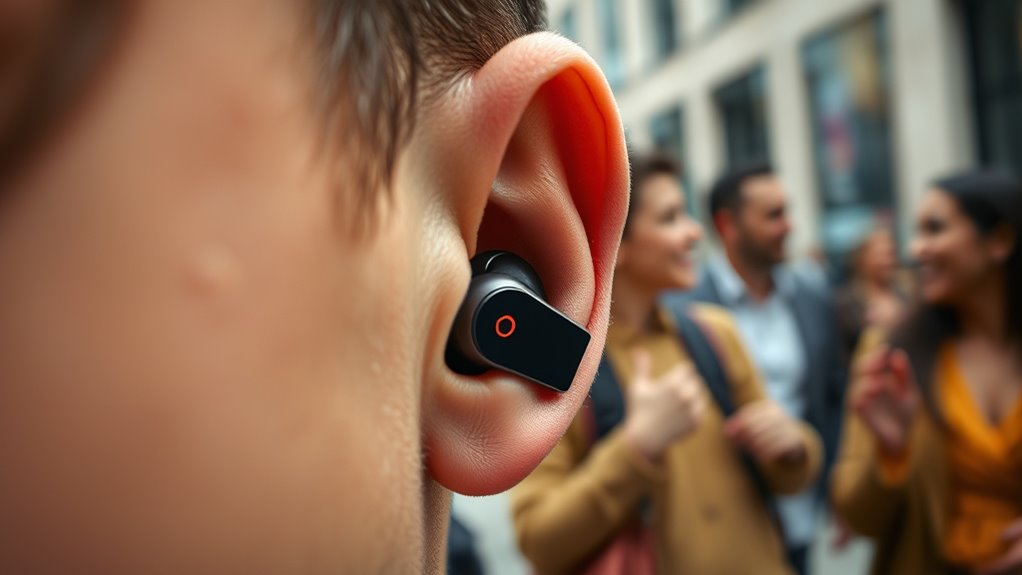
Real-world testing shows that AI translation earbuds perform well with simple, short phrases but reveal limitations during more complex or nuanced conversations. For example, the Timekettle M3 earbuds deliver near-perfect translation accuracy for brief Russian to English exchanges.
The W4 Pro earbuds handle Chinese to English in real time during light chats, with about 2.5 seconds delay. However, longer or more conversational sentences often cause errors or mistranslations, like confusing “breath” with “breasts.” Translation challenges can influence users’ choices of device based on their budget and needs. Additionally, cookie consent management highlights the importance of transparency and user control in digital tools.
The Anfier M3 achieves around 90% accuracy but sometimes stops mid-sentence and lacks emotional nuance. Translation performance can vary significantly depending on the complexity of the language input and context.
The S80 AL device, in simultaneous mode, faces translation delays and errors, such as translating “hotel” as “boxing” in French to English.
These examples show that language translation earbuds excel with short, simple inputs but struggle with complexity. Translation accuracy remains a critical factor impacting their practical use.
Strengths and Limitations in Accuracy and Usability
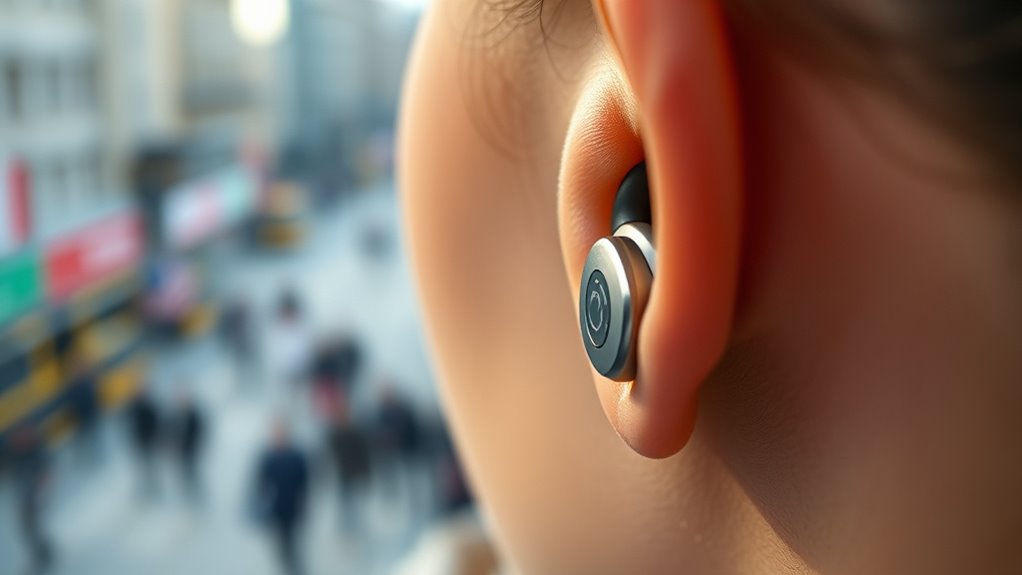
AI translation earbuds excel at accurately translating short, simple sentences, often reaching up to 98% correctness, which makes them useful for basic communication. Their strength lies in handling straightforward phrases, making quick exchanges reliable. Additionally, understanding different environments and contexts can improve the effectiveness of translation by tailoring responses appropriately. Recognizing linguistic nuances can further enhance translation accuracy, especially in more complex conversations. Being aware of cultural differences can also prevent misinterpretations and improve overall communication quality.
However, their accuracy drops with complex, nuanced language, leading to mistranslations or delays during longer conversations. You may find yourself repeating or adjusting your speech to maintain clarity, revealing limitations in speed and consistency.
Different models vary in performance; some deliver near-perfect results for simple phrases, while others misinterpret words like “breath” as “breasts.” Additionally, understanding the variety of dog breeds and traits can help users select more appropriate terms for clearer translation results. For example, recognizing different indoor gardening materials can inform better choices for specific applications.
Best Practices for Using Translation Devices Effectively

To get the most out of translation earbuds, it’s essential to use simple, clear sentences and speak naturally. This improves translation accuracy and helps the device understand you better. Utilizing high-quality content and engaging with your device through consistent practice can further enhance performance. Familiarize yourself with the device modes, and practice switching quickly between them to keep conversations flowing smoothly. Always keep your language packs and offline translation options updated to reduce delays and ensure reliable translations. Speak at a natural pace and volume; speaking too fast or loudly can cause recognition errors. Remember, these devices work best with routine phrases and simple statements.
Use these best practices to enhance your experience:
- Keep sentences short and straightforward
- Practice switching device modes efficiently
- Update language packs regularly
- Speak clearly at a normal pace
- Use routine phrases for better accuracy
Insights From User Feedback and Practical Experiences
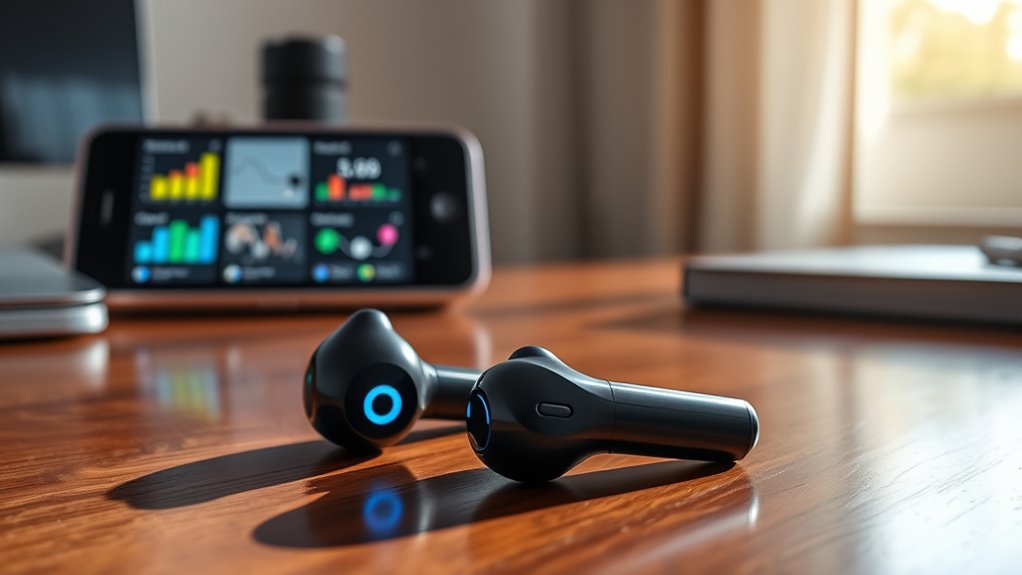
User feedback shows that AI translation earbuds work best with simple, short sentences but struggle with complex or emotional language. Many users notice delays and often need to repeat phrases, which can disrupt conversations.
Translation Accuracy Limits
While translation devices have made impressive strides, their accuracy often falls short in real-world conversations. You’ll notice that translation accuracy drops with complex language, idiomatic expressions, or emotionally charged speech.
Longer or conversational statements tend to cause delays, mistranslations, or awkward pauses, affecting reliability. Variations in accents, background noise, and speech clarity further impact performance, especially offline or in noisy environments.
User feedback reveals that accuracy can fall to around 90% or lower in tricky situations. Keep in mind:
- Short, simple sentences yield the best translation accuracy
- Complex language and idioms pose challenges
- Emotional or nuanced speech often mistranslates
- Environmental factors like noise reduce quality
- Manual adjustments are frequently necessary for clarity
These limits highlight the ongoing need for technological improvements.
Usability in Conversations
Despite advances in translation technology, users often find that AI earbuds perform best with short, straightforward exchanges. As a translator, these devices excel at basic language tasks like simple instructions or quick questions, providing near-perfect accuracy.
However, during longer or more complex conversations, delays and occasional mistranslations can occur, making real-time dialogue less reliable. You might need to repeat phrases to ensure understanding, which can interrupt the natural flow of conversation.
The earbuds struggle with nuanced language, emotional tone, and idiomatic expressions, limiting their effectiveness in dynamic discussions. Overall, they serve best for clear-cut exchanges rather than in-depth or highly nuanced conversations, highlighting the importance of keeping language simple for ideal usability.
Practical Application Tips
To get the most out of AI-powered translation earbuds, it’s essential to follow practical tips based on user feedback and real-world experiences. Keep conversations short and simple, as earbuds perform best with straightforward sentences, ensuring near-perfect accuracy.
For longer or nuanced discussions, switch to offline or touch modes for clearer translations, especially in noisy environments.
Regularly update your device’s software and double-check setup to prevent connection issues and boost translation speed.
Remember, earbuds are tools to assist, not replace professional interpreters for complex or sensitive conversations.
Customer service can help troubleshoot issues quickly, ensuring your earbuds work smoothly.
By following these tips, you’ll improve your translation experience and maximize your earbuds’ potential.
- Use simple sentences for better accuracy
- Switch modes during complex chats
- Keep software updated regularly
- Ensure proper setup to avoid connection issues
- Rely on customer service for troubleshooting
Comparing Devices: Which One Fits Your Needs?
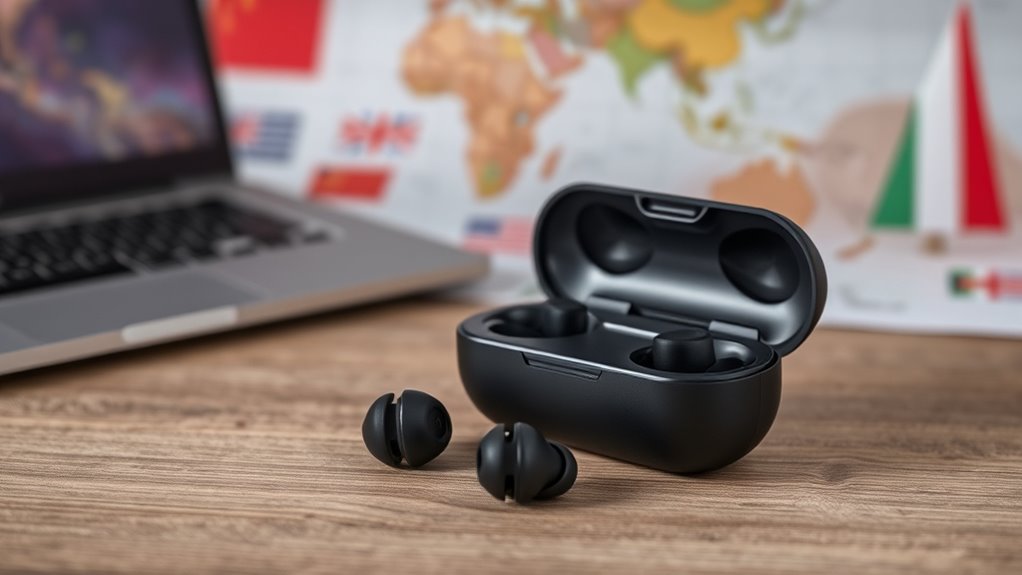
Choosing the right AI-powered language translation earbuds depends on your specific needs and environment.
If you travel often and need broad language coverage, the Anfier M3 supports 144 languages with about 97% accuracy, making it ideal for overcoming language barriers.
For travelers requiring extensive language options, the Timekettle M3 covers 40 languages and 93 accents with 95% accuracy, offering reliable translation on the go.
If offline translation is essential, the S80 AL supports 138 languages across 16 offline options, perfect for quick interpretation without internet.
For active users or outdoor adventures, the Bugani Free B10 provides 10 hours of battery life, IPX5 water resistance, and supports 40 languages.
Match the device’s features to your environment, language needs, and priority for accuracy and portability.
Future Trends and Innovations in Language Translation Technology
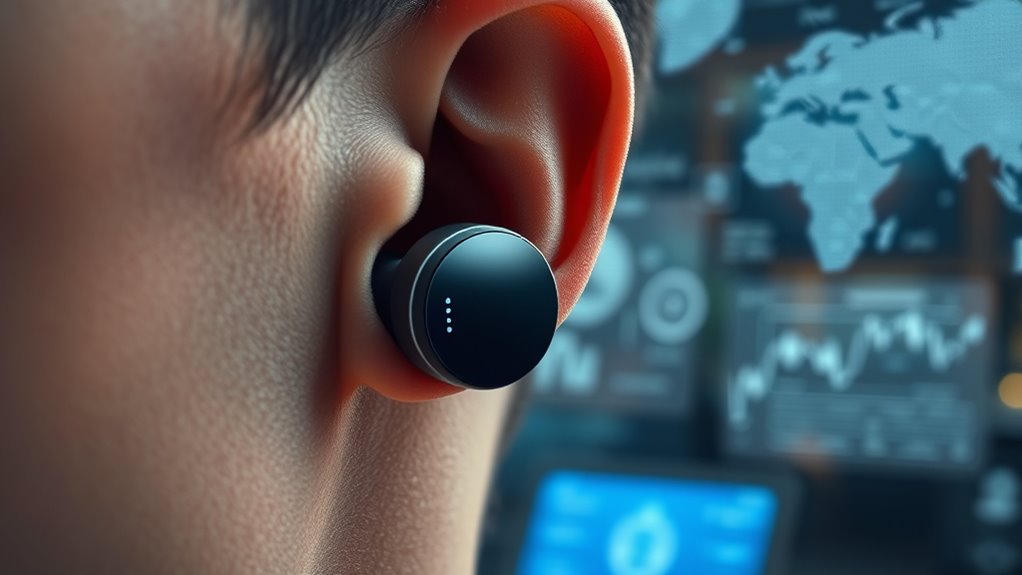
As technology advances, future language translation earbuds will become faster and more context-aware, providing near-instantaneous, seamless communication across multiple languages. You’ll see innovations like real-time multi-language switching, improved noise-cancellation, and adaptive speech recognition that handles diverse accents and environments.
Semantic segmentation technology will play a key role, enabling AI‑powered language translation earbuds to better understand complex conversations and nuanced meanings.
Expect longer battery life and more stable connections, supporting continuous use. Developers are also exploring hybrid hardware-software solutions that merge AI translation with augmented reality, creating immersive, hands-free multilingual experiences.
These advancements will make communication effortless, breaking down language barriers more effectively than ever before.
- Multi-language switching
- Enhanced noise-cancellation
- Adaptive speech recognition
- Extended battery life
- AR integration
Frequently Asked Questions
Do AI Translation Earbuds Require a Subscription?
You might wonder if AI translation earbuds need a subscription. Most models, like Timekettle M3 and W4 Pro, don’t require one for basic translation features.
However, if you want offline language packs or advanced cloud-based services, you may need to pay for a subscription or app upgrade.
Always check the specific product details to see what’s included for free and what might cost extra.
Which AI Earpiece Translates Languages?
Imagine having a personal interpreter in your ear, breaking down language barriers like a skilled diplomat. When you ask which AI earpiece translates languages, you’re stepping into a world of instant understanding.
The Timekettle M3, Anfier M3, and W4 Pro are your multilingual allies, supporting dozens of languages with impressive accuracy. These earbuds turn language confusion into clear conversations, making global communication feel as natural as a friendly chat.
How to Use AI Translation Earbuds?
You want to know how to use AI translation earbuds. First, connect them to your device via Bluetooth 5.4, making sure the connection’s stable.
Download the app, select your languages and offline packs.
Choose the right mode—touch, listen, or speaker—based on your conversation.
Speak naturally, then wait about 2.5 seconds for the translation.
Adjust the volume and noise settings in the app for clearer communication.
Is There a Monthly Fee for Translation Earbuds?
You’re wondering if you need to pay a monthly fee for translation earbuds. Generally, most models like Timekettle M3 and W4 Pro don’t require ongoing subscriptions for their core functions. You make a one-time purchase, and updates or offline language packs are usually free.
Some premium features or cloud services might cost extra, but basic translations are typically included without monthly charges. Always check the specific product details to be sure.
Conclusion
Think of AI translation earbuds as your personal bridge across language rivers. As you navigate new cultures, these devices act like sturdy boats, carrying your words smoothly over turbulent waters. Embrace their strengths, be mindful of their limits, and steer wisely. With each conversation, you build connections that transcend words—turning language barriers into stepping stones. In this journey, technology is your vessel, guiding you toward understanding and unity beyond borders.
